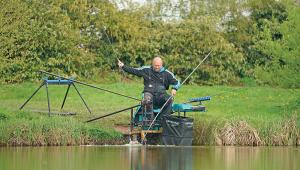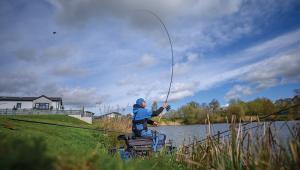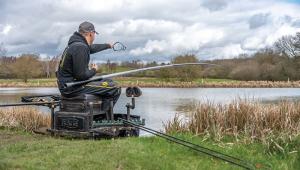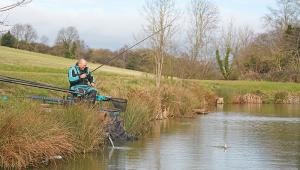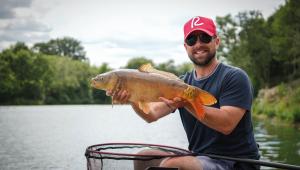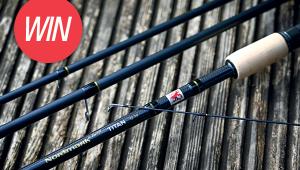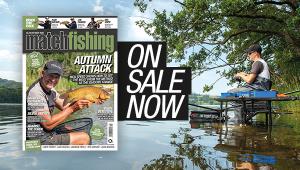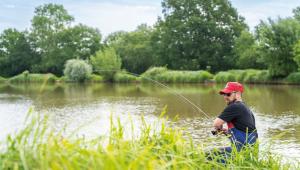Fast & Furious
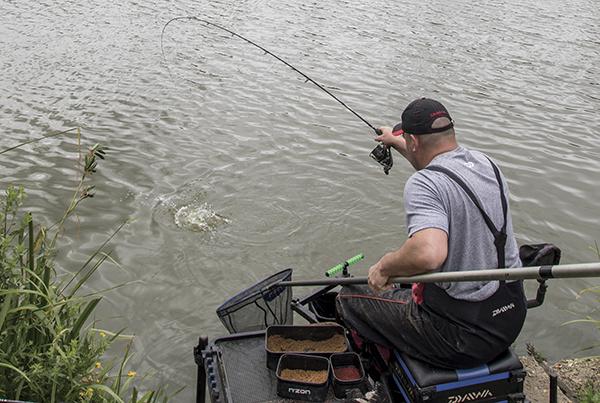
Catching a weight of F1s in the warmer weather is all about short pole lines, plundering the margins and the long pole if you are fishing snake-style venues. The tactics are commonplace whatever the weather conditions, as even on the windiest of days, if you can hold the pole steady then you will catch. It’s a completely different matter when you arrive at a lake that is affected by strong winds, as once there has been a blow on the water for any length of time, it starts to tow. As England international Will Raison pointed out when we joined him on Gold Valley’s Middle Lake, these are not the ideal conditions when F1s are the target.
“Since we’ve stocked F1s in Middle it’s clear that they aren’t particularly happy when there’s a lot of movement in the water,” he said, as he landed a small fish on his feeder setup. “That’s why I wanted to show you what’s been helping me to catch a big weight of F1s when those fishing the pole around me had been struggling.
“Let me fill in the details a little. Presentation and feeding are key when you fish a pole for F1s. You want your feed to fall below your rig, so that it pulls the fish to the hook bait, normally an expander.
However, when the water is towing, the loose feed – in this case micros – are pulled away from your bait, and the fish follow. On top of that, because you tend to fish a fairly light rig and hook bait, it might not even settle. “It is also less likely that there will be a lot of fish on the short line, as F1s are not great lovers of moving water, so when there is a strong tow, which you would normally find is worse around the outside of the lake, they will move towards the centre, where the tow is minimal.
“A switch to the feeder was in the back on my mind during last winter’s continuous gales, and it was after a couple of so-so results when the water was churning around the lake that I decided to try it, to see if would improve things.
“The first match in which I used the feeder, I didn’t go on it straightaway, and it took a while to get the fish on to the feed. I did end up coming second, only a few pounds off the winner, so I concluded that had I started on the feeder from the off, I could have won.
“It was still a good result, considering the winner caught his fish on the short pole, and his side of the lake was calm compared to where I sat.
“The next match, and yes, it blew a gale, so I made the decision to start on the feeder. I did set up a 5m pole line, but after plumbing up and dropping the rig in, it was clear that the water was pushing, and it didn’t feel right. I also set up a margin rig that I would possibly fish later on, as again there is always less tow down the edge and you will find F1s hugging the bank, away from the tow.
“I ended up winning the match, beating the best angler on the other bank, where the wind and tow didn’t affect the pole line so much. However, what stuck out more was the fact that the good anglers either side of me stuck with the short pole, where they struggled and posted a low weight.
“The two results were enough to convince me that the tactic was spot on when the conditions were against the short pole, but it’s not just about chucking out a feeder and catching loads of fish.
“There’s little doubt that the short pole is the best method to catch F1s, be it on expander and micros or casters shallow. They are both fast and efficient ways to catch. However, how do you translate that to fishing the feeder? You need to concentrate the fish on your hook bait, so a running feeder setup isn’t going to bring quick bites. A Method feeder will provide a concentration of feed, so that was my choice. I did think about micros and a small wafter, but it wouldn’t create that column through the water, so I felt that I wouldn’t get quick bites.
“The solution was clear – groundbait and maggots. It’s a combination that I would normally fish in the clear water in winter, as fishing it on the pole when the water is warm and coloured can be a foul-hooking nightmare, as it brings too many fish in and the feed just spreads them about. Fishing the pair on the feeder, however, can work, but to avoid the foul-hooking problem, I’ve sussed out a good way to present the hook bait in the feeder.”
Before Will revealed more, it was a good time to have a look at his gear for the session, and his choice of groundbait. It was a short chuck, about five metres off the rope on Middle Lake, so rod choice was a 10ft N’Zon Method feeder with a 0.75oz tip. Reel line was 8lb Daiwa ST mono loaded on an N’Zon 5000S reel. Feeder was a mini Guru Hybrid with a black X-Safe Quick Change elastic. Hook link was a size 14 or 16 Gamakatsu Gama Pellet hook on four inches of 0.15mm mono.
Hook bait was, as Will highlighted earlier, dead red maggots. Not necessarily the best F1 bait for the time of year, but an easy choice to bait up quickly, as speed was essential when targeting F1s.
“You need to be in and out, as quickly as possible, and it takes a matter of seconds to rebait with maggots, no fiddling about with bait bands or bayonets. I’ve clipped up, as you still need to ensure accuracy, as you would when fishing the pole.
“When it comes to groundbait choice, you still have to think about creating that column of feed falling through the water, so for me Daiwa’s Advantage F1 mix fits the bill. It breaks down very quickly once in water, and that could be a problem, as if it’s mixed too dry, it creates a big cloud that could pull the fish up in the water.
“The solution is to mix it slightly overwet, so that just enough breaks off as the feeder hits the water, and that means I need to load the feeder a little differently than normal. Instead of firmly moulding the groundbait around the feeder I fill it level with loose feed, and then push my thumb down to create a hollow. The hook bait is then placed in the hollow and covered with more loose feed. To finish, I firmly pinch the groundbait, so that it forms a peak. The theory is that when the feeder hits the water, the tip of the feed breaks off to create a small column of cloud. Then once on the deck, you get a ‘puff’ of feed that focuses the attention on the feeder, and because the maggots are in the bottom this helps to prevent foul-hooking fish.
“The fact that it’s groundbait will pull a lot of fish to the feeder, but as it’s a heavy mix, it doesn’t get washed all over the place. It works a little bit like the heavy groundbait you feed in the margins.”
The past 48 hours had seen the wind gusting up to almost 50mph, and there was still plenty of strength in the right-to-left breeze, as Will continued his session. F1 fishing is all about numbers, as you need to keep the small fish coming at a pace if you are going to build a weight.
“This type of fishing can be fast and furious, so you need to be out of the water for as little time as possible. I’m not fishing with light gear, so I can afford to be positive when I play my fish, and as soon as it’s in the keepnet I quickly rebait -– hence the maggots – add the feed and get the feeder back out.
“That being said, don’t be too quick to strike. There are going to be a lot of fish darting around the feed, so your tip is going to dance a bit. With a Hybrid feeder you are basically fishing a bolt rig, so you don’t need to strike. You need to wait for a firm pull on the tip. It’s easy to strike at the slightest indication, so I have changed the way I have my rod for this. Firstly, I have the rod in a butt rest, which means that I have to reach down to pick up it up. That little delay gives me time to pause if it’s not a proper bite.
“Secondly, I have the tip well off the water so that I can watch the line, as often you can detect a bite as it starts to tension when a fish is on, before it registers on the rod. There’s no need to have the tip under tension, as the Hybrid acts like a bolt rig, so once I cast I place the rod in the rest without tightening the line. It’s almost like the slack-lining tactic used by carp anglers.”
The session turned out to be a busy one, and once Will got into a rhythm he caught at a good pace. There were times when he lost a fish or missed the odd bite, but he had quickly built a good weight in the first hour.
During the next hour there were quiet spells, and Will pointed out that “you just have to fish through those,” as the fish will return quickly enough. However, if the bites did slow, he didn’t leave it too long before recasting.
“You have to think the same way as if you were fishing the pole. You want to keep that column of feed falling through the water, so be it Toss pot or that pinch of groundbait, it needs to be going in regularly.”
Interestingly, a little later in the session, Will started to occasionally feed small nuggets of groundbait on what would have been his ‘top five’ line. “During one particular match I was fishing into a head wind, so it was impossible to fish on the pole as presentation wouldn’t have been great, so out of interest I fed some small balls of feed short to see if I could catch short on the feeder later in the match.
“If it worked then I could catch even quicker, and as it turned out there were fish willing to feed, even though the conditions weren’t ideal. The bites were savage, so to avoid broken hook links I had to loosen the clutch.”
After adding no more than five nuggets over a 30-minute period, Will then lobbed his feeder over the short line, and the impact was instant. It was a bite a chuck! The switch greatly increased his catch rate, but not only that, the fish were bigger than those he had been catching at distance.
It had only been a short session at a little over three hours, but lifting out his nets Will estimated he had near on 80lb, a catch that he believed would not have been near the same amount had he fished the pole in the conditions. “I need to be clear that the feeder will never outfish the best F1 anglers on the pole when you have ideal conditions,” he concluded. “However, on venues like Middle Lake, if you are faced with extreme winds and there is a big tow on the water, then it’s a different ball game.
“It’s about making the correct call at the start of the match. If you do think the feeder will play a part, then you have to start on it if you want to keep pace with those who can fish the pole comfortably.
“I will still set up my pole, plumb up my short line and test the drag on my rig, and if it gets pulled along or doesn’t settle, then that’s when I make the decision to go for the feeder.
“Oh, and to add a little twist in your decision making, it’s worth checking the weather forecast, as you might turn up and the conditions are good, but during the match it’s predicted that the wind is going to get stronger.
“It doesn’t take long for a stiff breeze to affect the water, so again, it might make you think twice about your main attack. Do you catch well on the pole and suffer later, or keep it constant on the feeder and keep catching when the wind arrives? You can never switch off when it comes to catching F1s!”
- Log in or register to post comments

